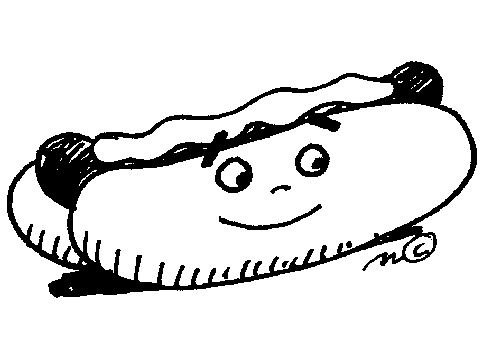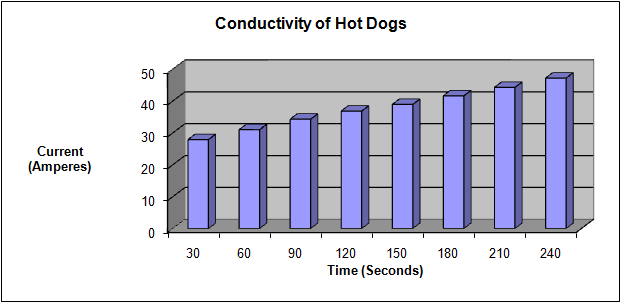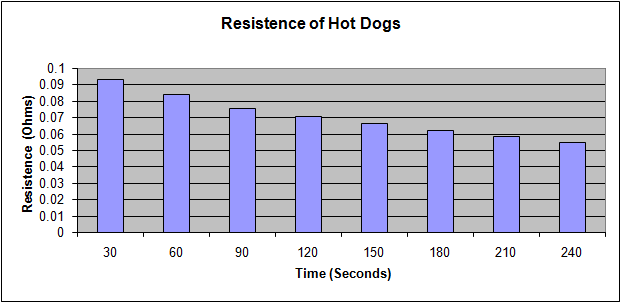
Specific Conductivity of Hot Dogs

"The noblest of
all dogs is the hot-dog; it feeds the hand that bites it."
Laurence J. Peter
Introduction |
Method | Conclusion and
evaluation | Additional information | Bibliography
| Return to Physics Research
Background information
To start broadly, I know that if a constant voltage is applied through a resistor, then as the resistance increases the current will subsequently decrease. In most objects, as you increase the temperature of the object the resistance increases because the heat causes the atoms which comprise the object to move around and collide more often. Because current is really the flowing of electrons, the increased movement hinders this flowing and that is why the resistance increases. However, I also know the boiling food increases the water content, and because tap water has minerals and salts which conduct electricity, this increase of water should increase the conductivity. At the same time, because I will be boiling the water to heat it the evaporation may cause some of those minerals and salts to leave the water and thus the hot dog.
Review of literature
The main sources I used talk mainly about the affect of heat on resistance as it was the area I knew the least about. First though, I learned a little bit about current to begin with. “When an electric current is created within a solid copper wire, the "electron sea" moves forward, but the protons within the positive atoms of copper do not” (Beaty). From there, I examined an experiment outline where I learned more about changing the resistance of an object. “Resistance is also affected by at least four physical factors, namely specific resistance of the material type, length, cross-sectional-area and temperature” (Banzhaf, Smith and Young). After seeing the word temperature in relation to resistance a red flag popped up and I tried to find more specific information on how temperature affected conductivity. I found what I was looking for on the US department of energy website where it was stated that, “When the wire heats up, for example, by a torch, it causes increasing chaos in the wire. This chaos causes the electrons to bump around more than before. Therefore, flow is with less ease. This means that the copper wire now has a higher resistance (Khounsary). The next thing I went about searching for was how much water would play a role in the conductivity. What I found was, “The high conductivity of salty water are the Salt-ions but water has in any case an amount of ions (Biehl). I learned that although water has the ability to carry charge, it is the minerals inside it which greatly up the capacity. My fear then was, because we were boiling the water that some of those minerals would leave the solution, “When hard water is heated, the carbonates precipitate out of solution...(Helmenstine).
Research question
How does the length of time you boil a hot dog (independent variable) in water affect the amount of current (dependent variable) which will pass through the hot dog with a constant voltage?
Hypothesis
The longer you cook (boil) the hot dog then the lower the
current will be because heating objects generally increases their resistance,
and the additional water content will partially evaporate causing any increase
it gave to become voided.
Variables
Our control variables will be the type of hot dog, the amount of water cooked in and the voltage pumped through the hot dog. The independent or experimental variable will be the length of time the hot dog is cooked for, and the dependent variable will be the conductivity, measured with current.
Materials
Our material list includes: 1 pack of 12 standard chicken-pork hot dogs, 1 power supply with appropriate probes and wires, 1 amp meter, 1 10-speed hot plate, 1 beaker capable of holding 700ml of water, tongs and paper towels.
Variable control
To control the variables will we attempt to prepare each hot dog in the same way prior to cooking by creating even segments and drying them fully. We will tape the positive and negative probes in a fixed position so that they will always be the same distance from each other, and we will attempt to place them in relatively the same place on each hot dog.
Procedure
First, fill the beaker with 700ml of warm tap water and place
in on the hot plate. Set the hot plate to the highest (10th) setting.
Next, lay down several sheets of paper towel on a solid, flat work space and
place your 12 hot dogs on them. Proceed to roll the hot dogs along the paper
towel to dry off the packaging juice. After hot dogs are dry, cut them into 5 cm
segments, you should be able to get 2 pieces per hot dog for a total of 24
testable hot dog nuggets.
While the water is boiling, set up your power supply so that it runs through the
amp meter and has the two probes connected to the other end of the amp meter.
Set it to a constant voltage, preferably under 3 volts to avoid burning and
subsequently exploding the hot dogs. We used 2.6 volts.
Once the water has reached a full boil, pick up the first nugget and place it
into the water. Begin timing as soon as it breaks the surface of the water and
be ready to pluck it out after 30 seconds.
After 30 seconds, grab the hot dog with the tongs and place it on a fresh piece
of paper towel and promptly insert the probes into the middle of the hot dog.
Record the current from your amp meter.
Repeat steps 4 and 5 with another nugget for a total of two trials.
Repeat the same process of testing hot dogs, increasing the time you cook it 30
seconds. You should hit: 30 sec, 1 min, 1:30, 2, 2:30, 3, 3:30 and 4. Make sure
you do two trials for each time interval.
Lab diagram

Data collection and processing


| Time (s) | Current 1 (A) | Current 2 (A) | Average Current (A) | Resistance (Ω) |
| 30 | 27.5 | 28.3 | 27.9 | 0.093189964 |
| 60 | 31.5 | 30.5 | 31 | 0.083870968 |
| 90 | 34.1 | 34.5 | 34.3 | 0.075801749 |
| 120 | 36.7 | 37 | 36.85 | 0.070556309 |
| 150 | 39 | 38.9 | 38.95 | 0.066752246 |
| 180 | 41 | 42.3 | 41.65 | 0.06242497 |
| 210 | 44.5 | 44.1 | 44.3 | 0.058690745 |
| 240 | 47.1 | 47.3 | 47.2 | 0.055084746 |
Drawing conclusions
Our data proved our hypothesis incorrect in its most basic form. That is to say that as the cooking time increased, the current passing through the hot dogs also increased. The average current able to pass through a hot dog cooked for 30 seconds was 27.9 A, after increasing the cooking time to 4 minutes, the current was averaged at 47.2 A, nearly double. The current change, when graphed, looks very linear, as does the resistance decay, which we calculated using V=IR, or Ohm's law. This relationship makes sense because ohms law states that there is a directly proportional relationship between current and resistance.
Evaluating procedures and results
Potential errors in our data our possible because of several limiting factors. In the interest of time, we never changed out the water we were using for cooking, so after time it was cloudy with hot dog resin. While I am not sure what this added content to the water would have changed, it is very possible that it did affect the way in which subsequent hot dogs were cooked. Also, while we tried to be as accurate as possible with where we placed the probes in the hot dog, we had no marks or measurements to insure it was exactly the same place each time. There was also the problem of the hot dogs cooling and drying in the time between taking them out of the boiling water and the insertion of the probe. All of these things could have had an impact on our collected data.
Improving the investigation
There are several ways we could work to improve this investigation. The first one would be to change the water between each test to insure that each hot dog had the same conditions. While time consuming, this option would eliminate any doubt that the conditions were the same for each test. Also, if there was a way to insert the probes into the hot dogs and leaving them there while they cooked, and only taking the reading at the appropriate time, we could eliminate the problem of cooling and drying in that dead space. Because of the discrepancies between what we expected based on research, that is temperature increasing and resistance increasing, and what happened, I would also like to take a temperature reading of the hot dog and pair it with the current flowing through it to see if the relationship we observed is directly correlated. If not it could lead to further investigations. One such investigation that I would like to see is a test in which one group of hot dogs are cooked in a dry way, such as a frying pan, and the other simply let to sit in water for an equivalent amount of time to see if it was the heat or water content which increased the conductivity the most.
Journal
of Food Science:
Discussion of the electrical conductivity of food as it relates to water content and
temperature.
News
Release from Dow Corning:
Heat resistance and electrical conductivity applied top various fields and areas
of study.
Journal
of Geophysical Research:
A research article on the correlation of electrical conductivity and heat flow.
Water
on the Web:
A useful collection of information on properties of water in a useful, glossary-type format.
Thai
Research on Electrical Conductivity:
A study of the applied field strength and electrical conductivity of food as it depends on the heating rate.
Banzhaf, Walter, E.K. Smith, and Winfield Young."Effect of Temperature on Resistance." Educators Corner. University of Hartford. 11 Jan. 2007 <http://www.educatorscorner.com/media/Exp91c.pdf>.
Beaty, William. Which Way does the “Electricity” Really Flow?. 1996. 11 Jan. 2007 <http://amasci.com/amateur/elecdir.html>.
Biehl, Ralf Ph.D."Water itself is not a conductor of electricity." Ask the Experts. University Of Mainz. 11 Jan. 2007 <http://www.physlink.com/Education/AskExperts/ae61.cfm>.
Helmenstine, Anne Marie Ph.D."Water Works." Chemistry of Hard and Soft Water. About.com. 11 Jan. 2007 <http://chemistry.about.com/cs/howthingswork/a/aa082403a.htm>.
Khounsary, Ali Ph.D."Temperature and Conductivity." Ask A
Scientist. US Department of Energy. 11 Jan. 2007 <http://www.newton.dep.anl.gov/askasci/phy99/phy99x42.htm>.
Seth Jenkins | Neil LaTourette |
Brenden Liverman
2007